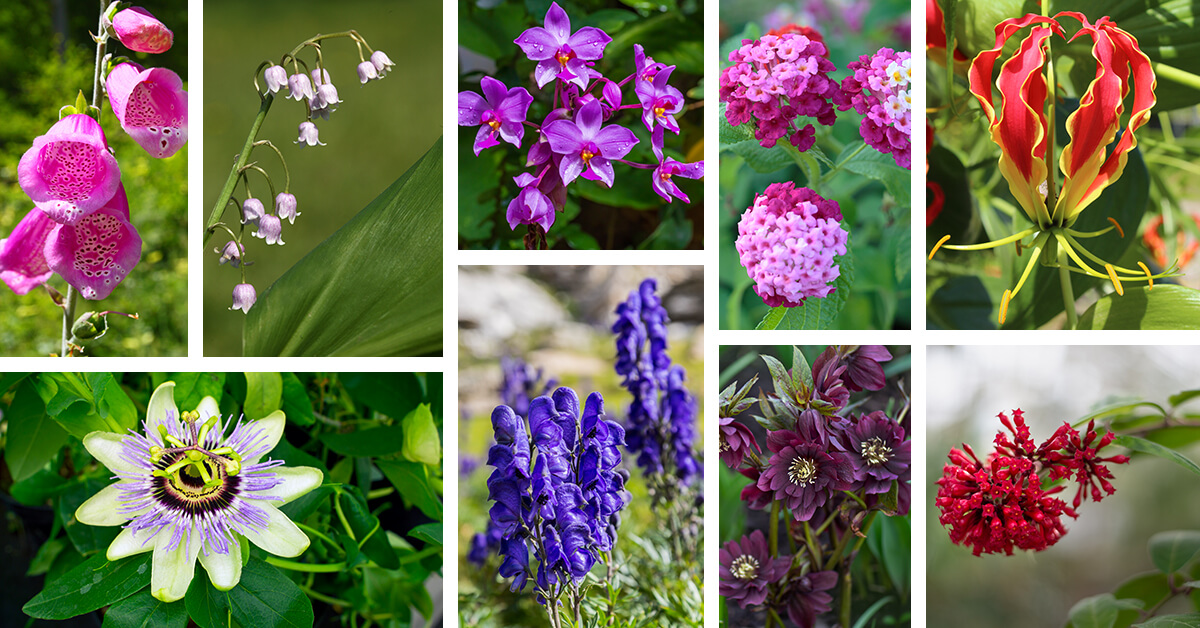Poisonous flowers walk the exhilarating balance between intense beauty and electrifying danger. From poisonous flower identification to an exciting new botanical challenge, there are many reasons to seek out which flowers are dangerous. Maybe you would like a new adventure for your garden this year. You may recognize some flowers on this list, while others might be new.
27 Most Interesting Poisonous Flowers to Plant for a Dangerously Beautiful Garden

Many are also poisonous to dogs and cats as well as being poisonous to people. There are also varying degrees of toxicity — some flowers must be ingested in large amounts to cause harm, while others can hurt anyone who touches them. Whatever is your goal our list can help you to choose the best poisonous plants for your garden.
1. Periwinkle (Vinca Minor)
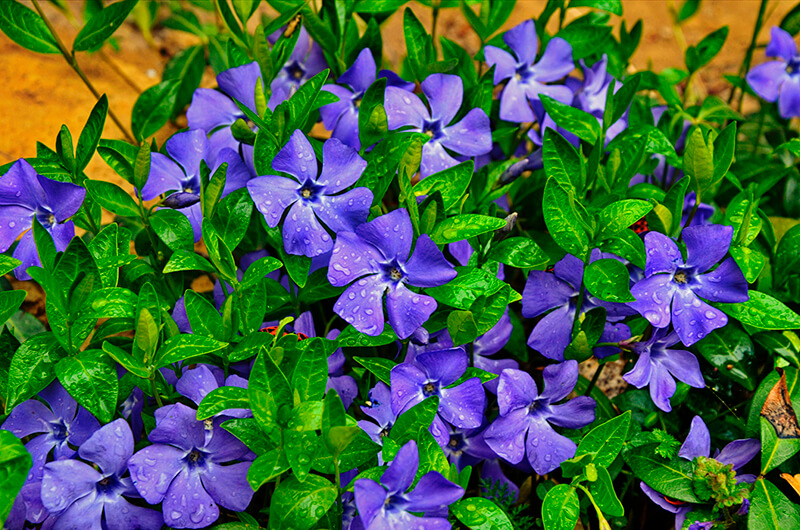
- 🔮 Symbolism: Friendship, nostalgia
- 💧 Water needs: Dry to medium, tolerates drought
- 🪴 Soil needs: Average soils with good drainage
- 🌍 Growing zones: 4 to 8
- ☀️ Light needs: Full sun to part shade
- 🌱 Blooming season: May to June
As a popular groundcover, periwinkle adds a beautiful element to the landscape while preventing soil erosion. It is poisonous if ingested, but does not cause skin irritation which means it can happily go along shady paths or places where it might be touched. However, it is highly toxic for dogs, cats, and horses.
2. Scotch Heather (Calluna Vulgaris)
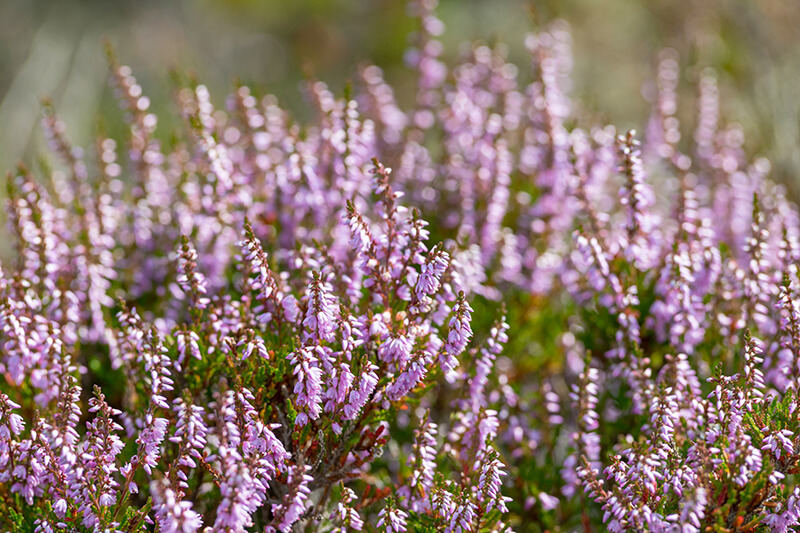
- 🔮 Symbolism: Joyful solitude
- 💧 Water needs: Medium
- 🪴 Soil needs: Acidic, gravelly-type soils with good drainage
- 🌍 Growing zones: 4 to 6
- ☀️ Light needs: Full sun to part shade
- 🌱 Blooming season: July to September
Although dangerous if eaten, Scotch heather is absolutely resplendent when in bloom. These spiky purple inflorescences can enliven any landscape and are a fantastic poisonous flower to plant. However, because they have a shallow root system, it is not recommended to interplant with any other flowers.
3. Dumbledore’s Delight (Aconitum Napellus)
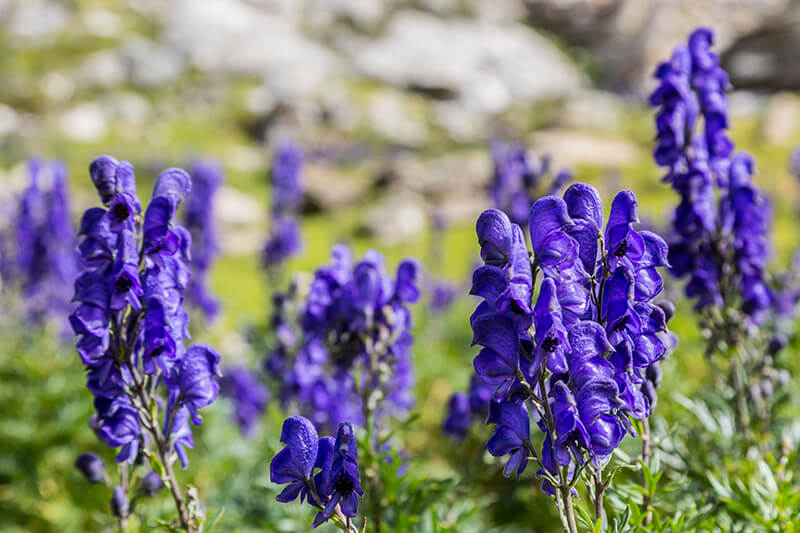
- 🔮 Symbolism: Chivalry, villainy
- 💧 Water needs: Medium
- 🪴 Soil needs: Moist soils with good drainage
- 🌍 Growing zones: 3 to 7
- ☀️ Light needs: Full sun to part shade
- 🌱 Blooming season: July to August
With its sculptural column-like flowers, Dumbledore’s Delight adds purple joy to any landscape. However, because all parts of this plant are poisonous, it should not be planted close to paths or other spaces where accidental physical contact might happen. When working with Dumbledore’s Delight, gloves should be worn and open wounds must be covered.
4. Cestreau Élégant (Cestrum Elegans)
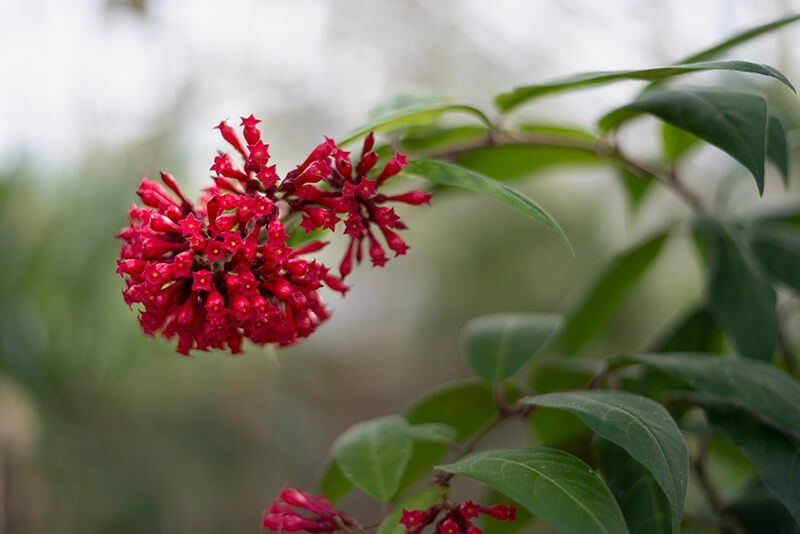
- 🔮 Symbolism: Elegance
- 💧 Water needs: Dry to medium
- 🪴 Soil needs: Average, well-draining soil, Tolerates mild drought
- 🌍 Growing zones: 8 to 11
- ☀️ Light needs: Full sun to part shade
- 🌱 Blooming season: May to September
As seen in pictures of these poisonous flowers, cestreau élégant offers a little tropical flair to an otherwise monotonous landscape. Showy tubular flowers and glossy berries are beautiful, but poisonous if eaten. Because this woody shrub enjoys climbing, it is best grown by gardeners who find pruning a relaxing pastime.
5. Meadow Saffron (Colchicum Autumnale)
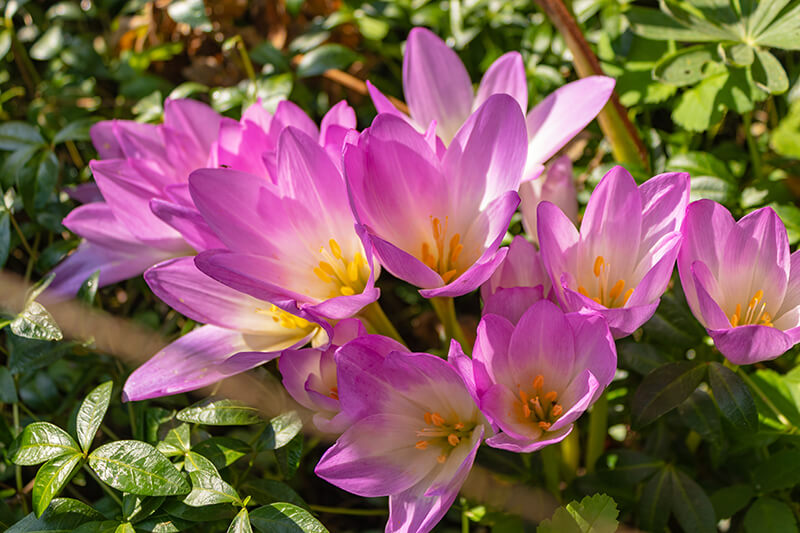
- 🔮 Symbolism: Good memories
- 💧 Water needs: Medium
- 🪴 Soil needs: Rich soils with good drainage
- 🌍 Growing zones: 4 to 8
- ☀️ Light needs: Full sun to part shade
- 🌱 Blooming season: August to September
Blooming between summer and fall, these are the perfect poisonous flowers to plant for the gap between summer-blooming flowers and fall-blooming flowers. While only toxic to humans if eaten, these crocus-like flowers look great next to paths or patios. Be aware that they are highly poisonous to a variety of animals including dogs and cats.
6. Lily of the Valley (Convallaria Majalis var. Rosea)
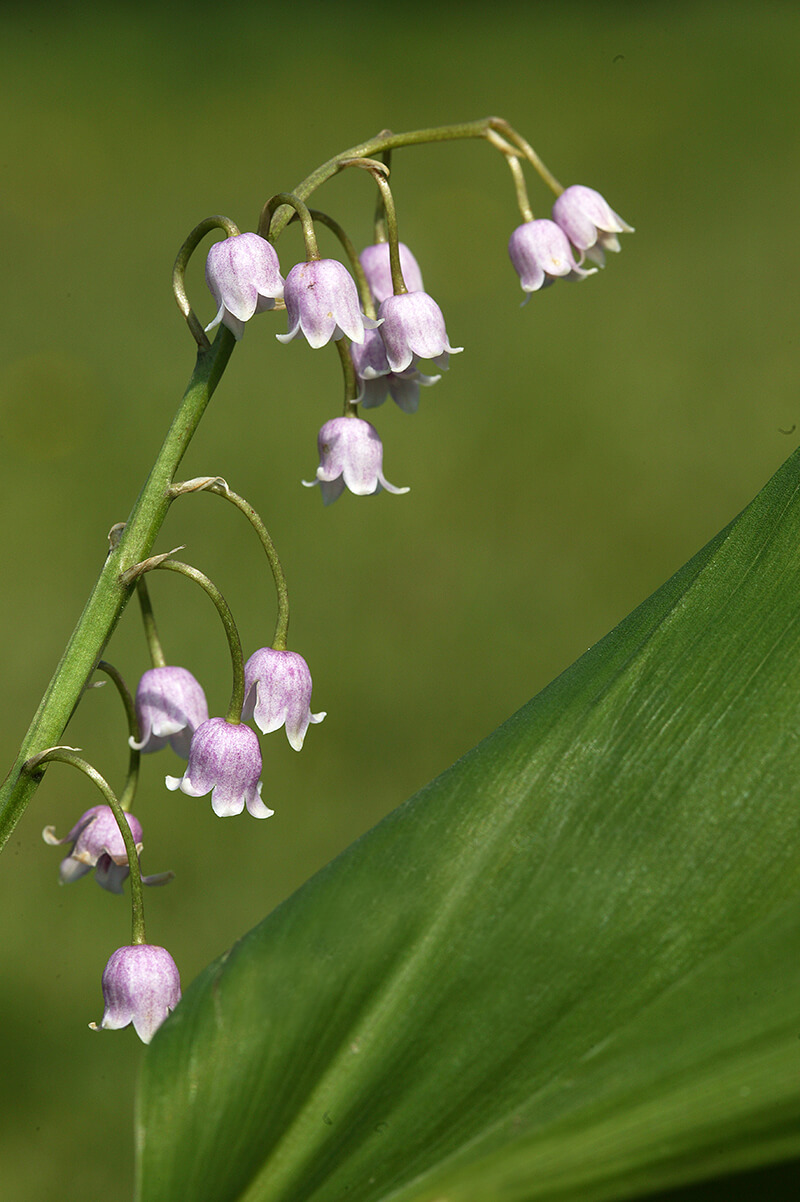
- 🔮 Symbolism: Reconciliation, Happiness returning
- 💧 Water needs: Medium
- 🪴 Soil needs: Fertile soil with good drainage
- 🌍 Growing zones: 2 to 7
- ☀️ Light needs: Part shade to full shade
- 🌱 Blooming season: April to May
Images of these poisonous flowers show a delicate bell-shaped bloom tinged with pink. As a staple of the shade garden, the lily of the valley flower offers elegance in the shadows. Consuming any part of this plant causes violent illness in people, dogs, cats, and horses, and should be located accordingly in the garden.
7. Mysterious Plant (Daphne Mezereum)
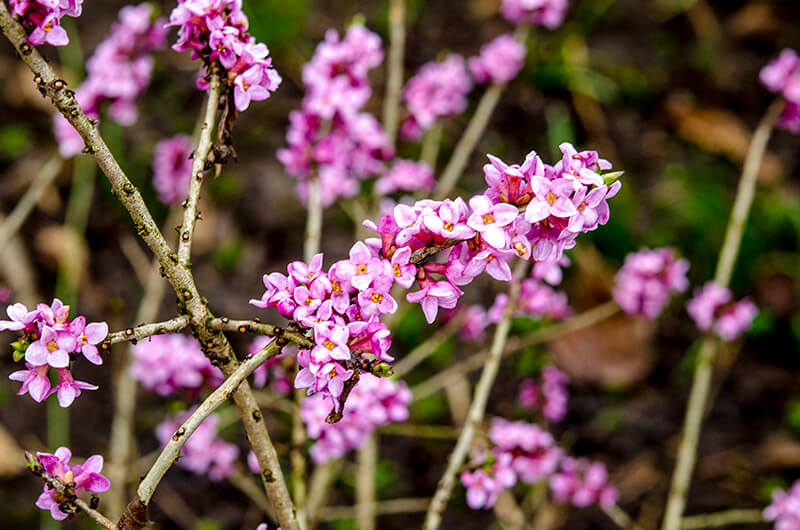
- 🔮 Symbolism: Motivation to satisfy
- 💧 Water needs: Medium
- 🪴 Soil needs: Slightly alkaline, humus-type sandy soil with good drainage
- 🌍 Growing zones: 4 to 7
- ☀️ Light needs: Full sun to part shade
- 🌱 Blooming season: March to April
Although birds can consume the fruits from these types of poisonous plants, all parts of the mysterious plant are toxic to humans. Even the sap from broken stems can cause skin irritation. However, the springtime pink petals on this shrub make it an excellent plant to use as an informal hedge.
8. Larkspur (Delphinium – Belladonna Group)
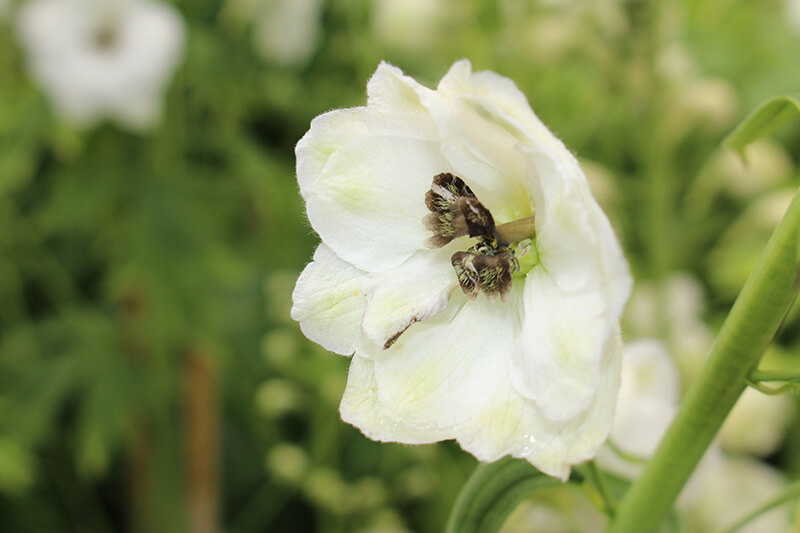
- 🔮 Symbolism: Sustained good luck, light in spirit
- 💧 Water needs: Medium
- 🪴 Soil needs: Fertile humus-type soils with good drainage
- 🌍 Growing zones: 3 to 7
- ☀️ Light needs: Full sun
- 🌱 Blooming season: May to July
Well-suited to hotter climates, larkspur in the belladonna group can handle hot, humid summers. Because these types of poisonous flowers do take some maintenance like staking and deadheading, including them in your garden is a time commitment. However, their flashy flowers make all that work worth the effort.
9. Witches’ Bells (Digitalis Purpurea – Excelsior Group)
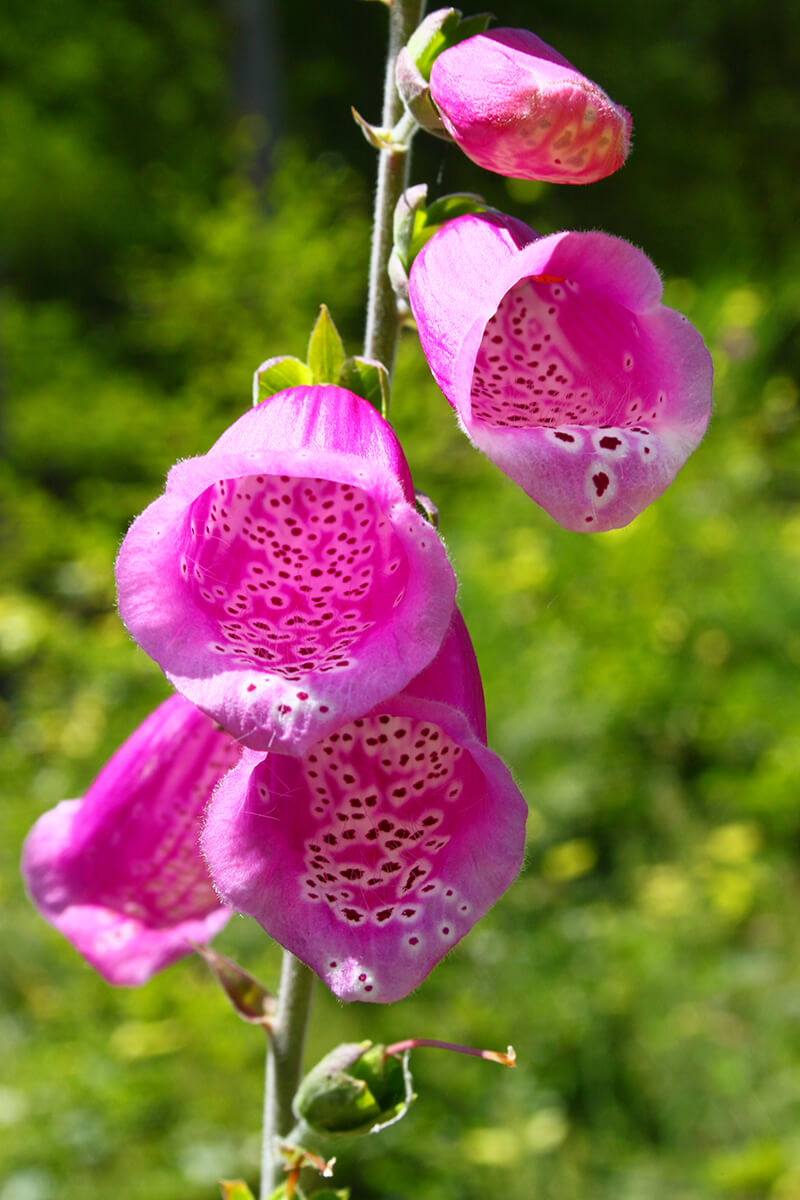
- 🔮 Symbolism: Childhood, humility, and submission
- 💧 Water needs: Medium
- 🪴 Soil needs: Acidic soil with good drainage
- 🌍 Growing zones: 4 to 8
- ☀️ Light needs: Full sun to part shade
- 🌱 Blooming season: June to July
Witches’ Bells might be poisonous to animals like dogs and cats, but add the element of magnificence to a landscape. Because each flower column is about four feet tall, these biennial perennials are masters at catching the eye. If grown in great conditions, these flowers will self-seed to provide a show every year.
10. Japanese Loquot (Eriobotrya Japonica)
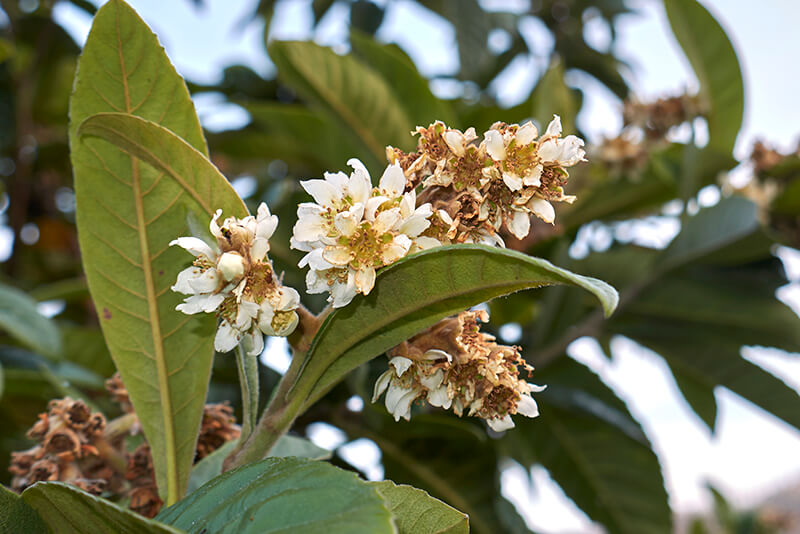
- 🔮 Symbolism: Marriage, gold, and wealth
- 💧 Water needs: Medium
- 🪴 Soil needs: Fertile, loamy-type soils with good drainage
- 🌍 Growing zones: 8 to 10
- ☀️ Light needs: Full sun to part shade
- 🌱 Blooming season: November to December
To enjoy lovely wintertime flowers, a Japanese loquot might be the plant for you. Because only the seeds are toxic, it is marginally safer than other types of poisonous flowers. If you live in a hardiness zone north of those listed here, you can still grow your own Japanese loquots as container plants.
11. Purple Passionflower (Passiflora Incarnata)
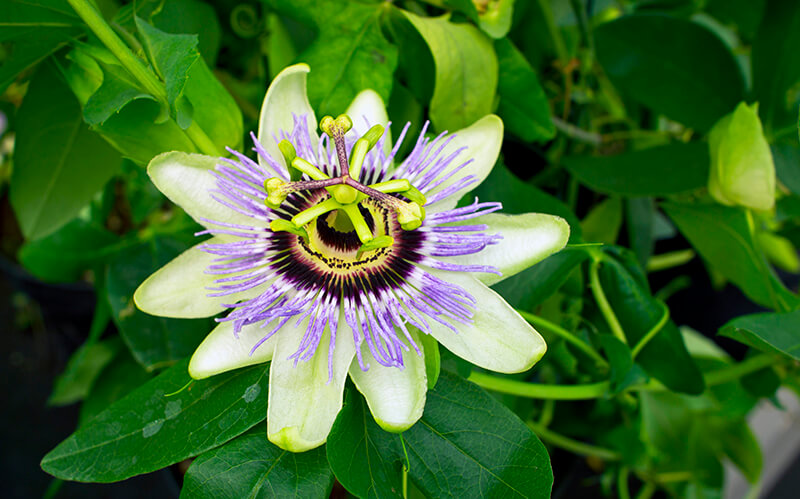
- 🔮 Symbolism: Faith
- 💧 Water needs: Medium, tolerates drought
- 🪴 Soil needs: Average soils with good drainage
- 🌍 Growing zones: 5 to 9
- ☀️ Light needs: Full sun to part shade
- 🌱 Blooming season: July to September
Although purple passionflower produces an edible fruit commonly known as a maypop, the glamorous flowers can cause life-threatening illness if eaten. In looking at images of these poisonous flowers, you might expect them to come from a tropical climate. In fact, the purple passionflower is native to the United States heartland.
12. Hellebore (Helleborus ‘Mardi Gras Double Mix’)
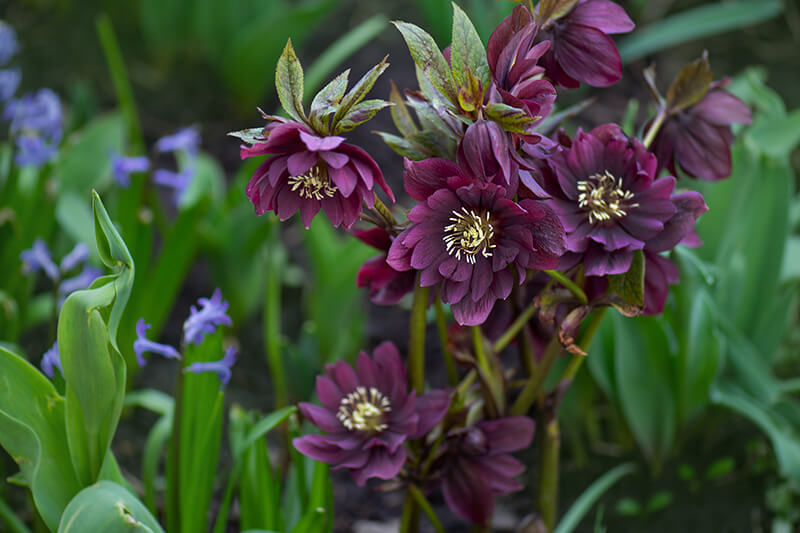
- 🔮 Symbolism: Serenity, tranquility and peace
- 💧 Water needs: Medium
- 🪴 Soil needs: Fertile, alkaline soils with good drainage
- 🌍 Growing zones: 5 to 9
- ☀️ Light needs: Part shade to full shade
- 🌱 Blooming season: February to April
Most varieties of hellebore provide simple flowers, but this variety showcases massive double flowers from late winter until mid-spring. Hellebore may look beautiful, but it is poisonous to humans, cats, dogs, and horses. One benefit to hellebore’s toxic nature is that rabbits and deer tend to stay away from the flowers.
13. Carolina Yellow Jasmine (Gelsemium Sempervirens)
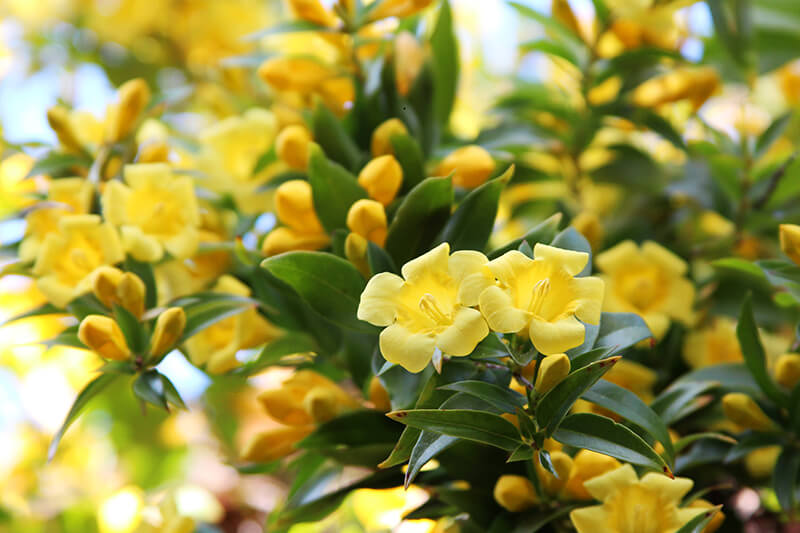
- 🔮 Symbolism: Happiness and friendship, optimism
- 💧 Water needs: Medium
- 🪴 Soil needs: Fertile soil with good drainage
- 🌍 Growing zones: 7 to 10
- ☀️ Light needs: Full sun
- 🌱 Blooming season: February to April
As you can see in pictures of these poisonous flowers, Carolina yellow jasmine’s yellow blooms almost seem too cheerful to be toxic. As well as being dangerous to ingest, Carolina Yellow Jasmine irritates the skin. However, it makes the perfect addition to patios and can create a vibrant ambiance when used as a groundcover.
14. Gloriosa Lily (Gloriosa Superba ‘Rothschildiana’)
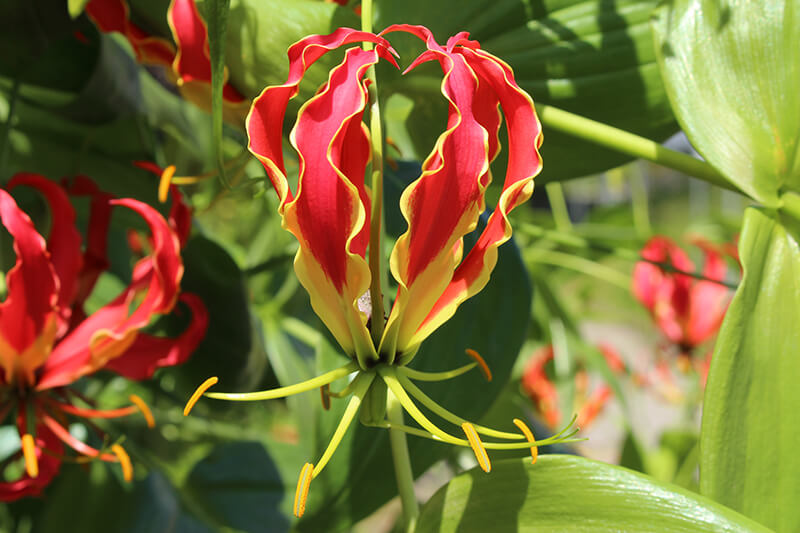
- 🔮 Symbolism: Passion, proud, honor and glory, but can also represent purity and beauty
- 💧 Water needs: Medium
- 🪴 Soil needs: Fertile soil with good drainage
- 🌍 Growing zones: 8 to 10
- ☀️ Light needs: Full sun to part shade
- 🌱 Blooming season: July to September
Extravagant and unique, the gloriosa lily offers flowers that are startlingly beautiful. In a show of utter magnificence, ruffled petals extend to the sky while vibrant green stamens swoop towards the ground. Do not be fooled by the sumptuous grace, however. All parts of this plant are poisonous to humans and several types of animals.
15. St. John’s Wort (Hypericum Calycinum)
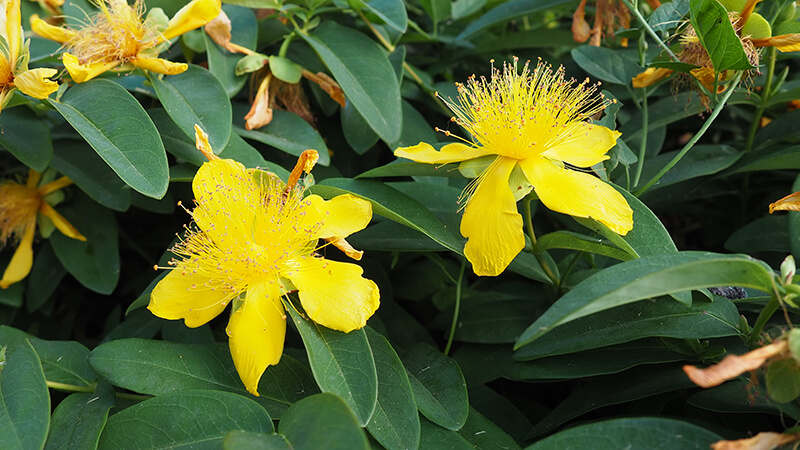
- 🔮 Symbolism: Spiritual protection, symbol of the Midsummer Solstice
- 💧 Water needs: Medium
- 🪴 Soil needs: Sandy soil with good drainage, tolerates a wide range of soil types
- 🌍 Growing zones: 5 to 9
- ☀️ Light needs: Full sun to part shade
- 🌱 Blooming season: July to August
With a spray of filament-like stamen, these yellow flowers radiate a tropical ambiance in a more temperate cool climate. Because St. John’s Wort is a low-lying shrub, it works spectacularly when used as a groundcover. As well as preventing erosion, it provides a profusion of yellow cheerfulness all summer long.
16. Cariaquillo (Lantana Camara)
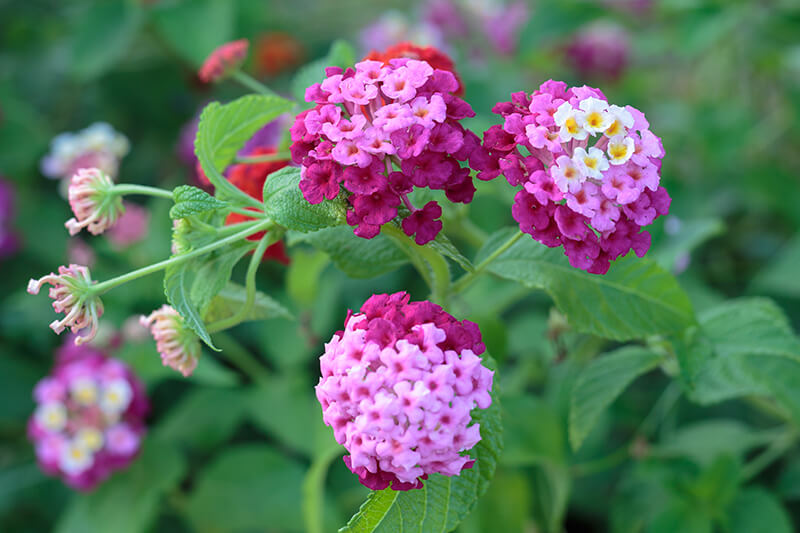
- 🔮 Symbolism: Vitality
- 💧 Water needs: Medium
- 🪴 Soil needs: Average soils with good drainage
- 🌍 Growing zones: 10 to 11
- ☀️ Light needs: Full sun
- 🌱 Blooming season: July until frost
Hailing from the rich tropics of South America, cariaquillo provides a garden with an explosion of color. Each flower cluster can showcase more than one color with possibilities including purple, orange, red, yellow, and white. However, you do need to be careful as these plants are highly poisonous to people as well as animals.
17. Scarlet Sage (Lobelia Cardinalis ‘Queen Victoria’)
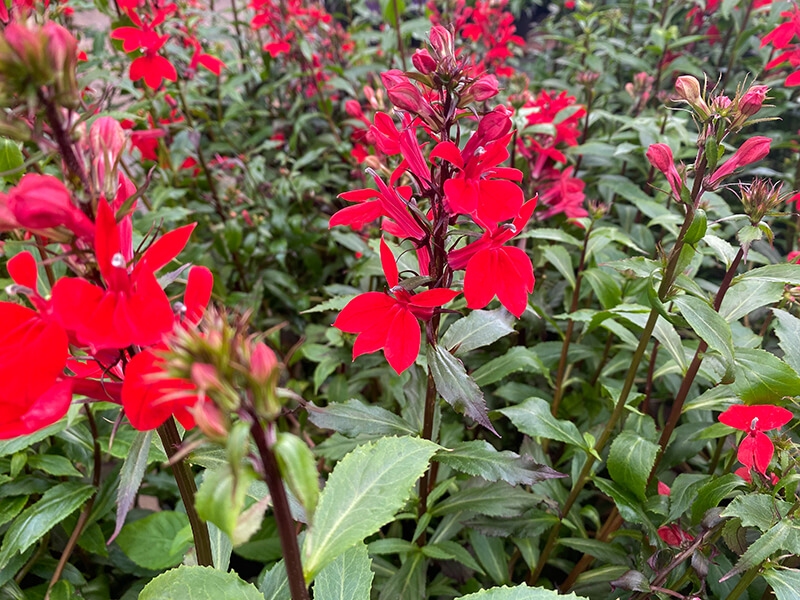
- 🔮 Symbolism: Longevity, wisdom, esteem, and good health
- 💧 Water needs: Medium to wet, tolerates flooding
- 🪴 Soil needs: Rich, water-retentive soils
- 🌍 Growing zones: 4 to 9
- ☀️ Light needs: Full sun to part shade
- 🌱 Blooming season: July to September
The perfect poisonous flower to plant in your rain garden, scarlet sage attracts both birds and butterflies. ‘Queen Victoria’ is better suited to life in a garden and will bless your landscape with its trademark tubular red flowers. However, you will want to keep these toxic flowers out of reach of dogs, cats, and small children.
18. Lupine (Lupinus × Hybrida)
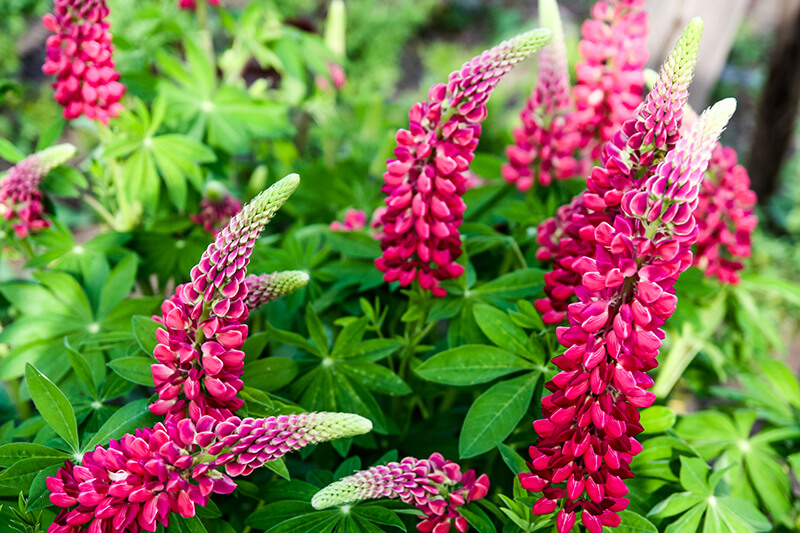
- 🔮 Symbolism: Ambition, imagination, admiration, and overall happiness
- 💧 Water needs: Medium
- 🪴 Soil needs: Slightly acidic, fertile soil with good drainage
- 🌍 Growing zones: 4 to 8
- ☀️ Light needs: Full sun
- 🌱 Blooming season: May to July
Preferring cool climates to hot ones, lupine can be treated either as a short-lived perennial or a single-season annual. Massive spires of intensely-colored flowers catch the eye from mid-spring until mid-summer. Because the inflorescences make excellent bouquets, they are a great addition to cut-flower gardens. Like most poisonous flowers, however, they can cause serious illness if eaten.
19. Star of Bethlehem (Ornithogalum Arabicum)
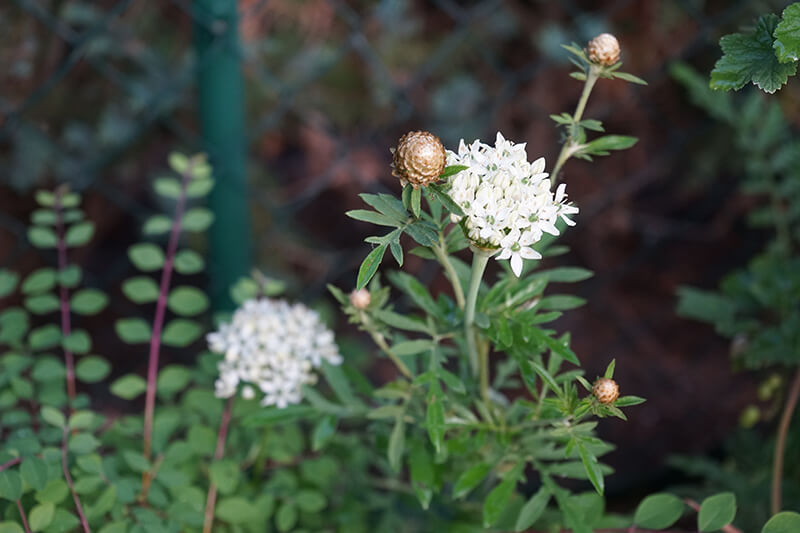
- 🔮 Symbolism: Forgiveness, innocence, purity, honesty, hope
- 💧 Water needs: Medium
- 🪴 Soil needs: Average soil with good drainage
- 🌍 Growing zones: 8 to 10
- ☀️ Light needs: Full sun to part shade
- 🌱 Blooming season: June to July
Although Star of Bethlehem features star-shaped white flowers, it is sophisticated enough not to try to be the star of the show. As you can see in the images of these poisonous flowers, star of Bethlehem exudes subtle elegance instead of gaudy glitz. While some types spread aggressively, this variety stays where you plant it.
20. Mountain Fire (Pieris japonica)
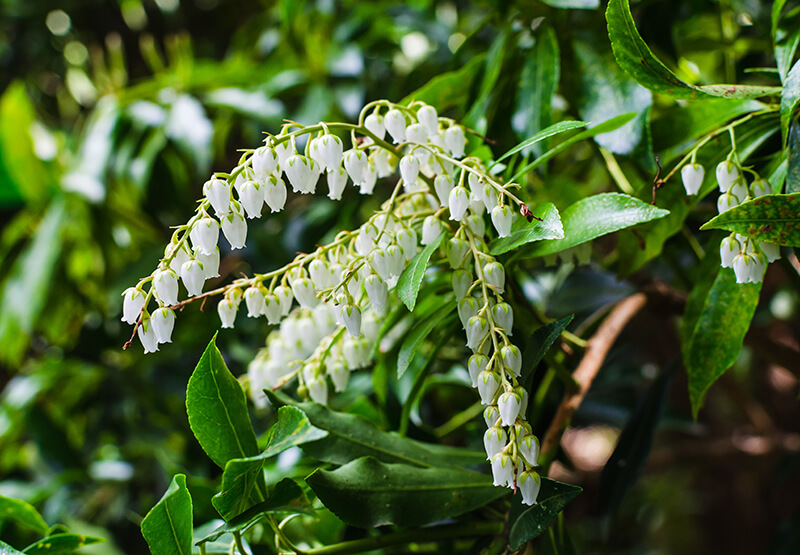
- 🔮 Symbolism: Sweetness
- 💧 Water needs: Medium
- 🪴 Soil needs: Fertile, slightly acidic soil with good drainage
- 🌍 Growing zones: 5 to 8
- ☀️ Light needs: Full sun to part shade
- 🌱 Blooming season: April
Even if they are poisonous, dripping cascades of white bells are a beautiful feature in a spring garden. While the image shows white flowers, mountain fire cultivars can be found with pink flowers. For maximum effect, pair this evergreen shrub with other bushes that also love acidic soil.
21. Butterfly Flower (Asclepias tuberosa)

- 🔮 Symbolism: Farewell, the victory over death
- 💧 Water needs: Dry to medium, tolerates drought
- 🪴 Soil needs: Average soil with good drainage
- 🌍 Growing zones: 3 to 9
- ☀️ Light needs: Full sun
- 🌱 Blooming season: June to August
True to its name, these clouds of bright orange flowers do a great job of attracting butterflies. For the first two years of its life, this poisonous plant does not flower. However, mature butterfly flower bushes produce some of the most vivacious blooms possible for a wildflower.
22. Mayapple (Podophyllum peltatum)
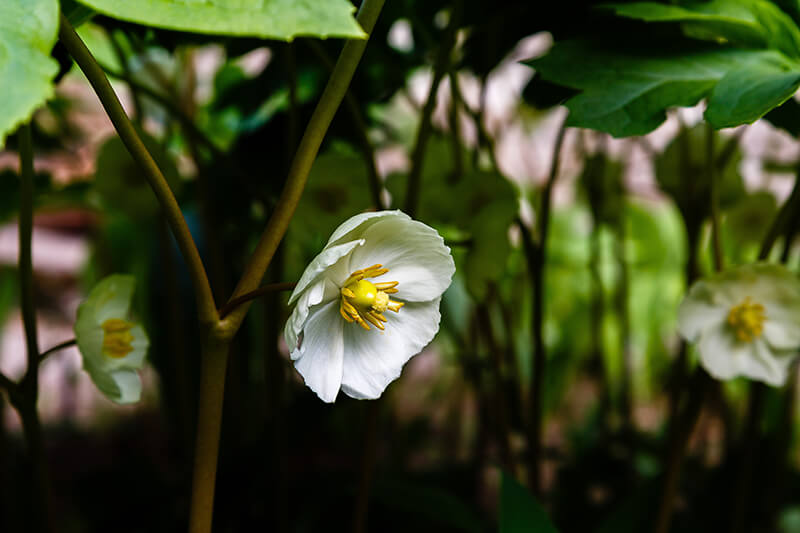
- 🔮 Symbolism: Fertility
- 💧 Water needs: Medium
- 🪴 Soil needs: Average soils with good drainage
- 🌍 Growing zones: 3 to 8
- ☀️ Light needs: Part shade to full shade
- 🌱 Blooming season: April
Mayapple is a native wildflower that goes dormant during the summer. Large, umbrella-shaped leaves partially conceal the flashy white flowers. This concealment helps this poisonous plant feel like a treasure hunt. While they produce edible fruit, the roots and leaves of this wildflower are toxic to people and animals.
23. Versailles Laurel (Prunus Laurocerasus)
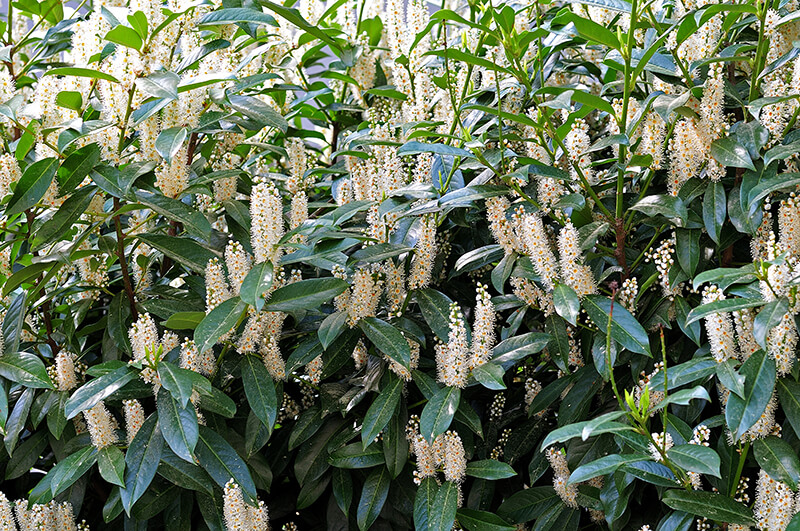
- 🔮 Symbolism: Auspicious, achievement
- 💧 Water needs: Medium
- 🪴 Soil needs: Fertile soils with good drainage
- 🌍 Growing zones: 6 to 8
- ☀️ Light needs: Full sun to part shade
- 🌱 Blooming season: April to May
Beyond creating a visual feast, Versailles laurel releases a powerful fragrance. Even if they are toxic, sprays of tiny white flowers are quite the springtime show. Evergreen foliage adds a green element when all the other plants in your garden are turning colors in the fall.
24. Brazilian Nightshade (Solanum Seaforthianum)
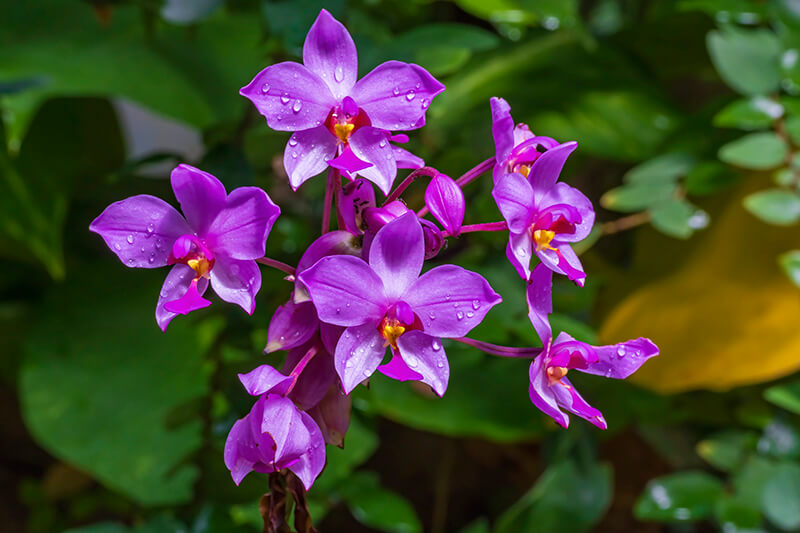
- 🔮 Symbolism: Deceipt
- 💧 Water needs: Medium, Tolerates drought
- 🪴 Soil needs: Fertile soil with good drainage
- 🌍 Growing zones: 11 to 12
- ☀️ Light needs: Full sun to part shade
- 🌱 Blooming season: July to August
Accented with yellow stamen, flashy blue and purple flowers will dazzle. As a woody vine, it is best given a structure to climb. Although poisonous if ingested, Brazilian nightshade is safe to touch and can be handled without gloves. These types of poisonous flowers are invasive in Hawaii as well as some parts of Florida.
25. Angel Trumpet (Brugmansia × Candida)
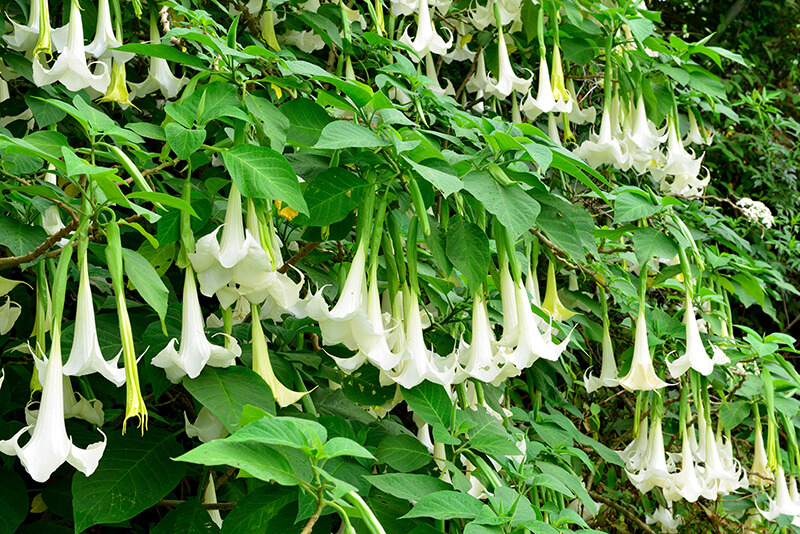
- 🔮 Symbolism: Insanity, concealment
- 💧 Water needs: Medium
- 🪴 Soil needs: Very rich soil with good drainage
- 🌍 Growing zones: 8 to 10
- ☀️ Light needs: Full sun
- 🌱 Blooming season: Blooms seasonally
Huge, foot-long white flowers dangle from this broadleaf evergreen tree to achieve an extravagant effect in your landscape. At night, these flowers exude a sweet fragrance so strong that it masks the volatile tropane alkaloids it also emits. These organic compounds can cause headaches if you are exposed to them for a prolonged period.
26. Viper’s Bugloss (Echium Vulgare)
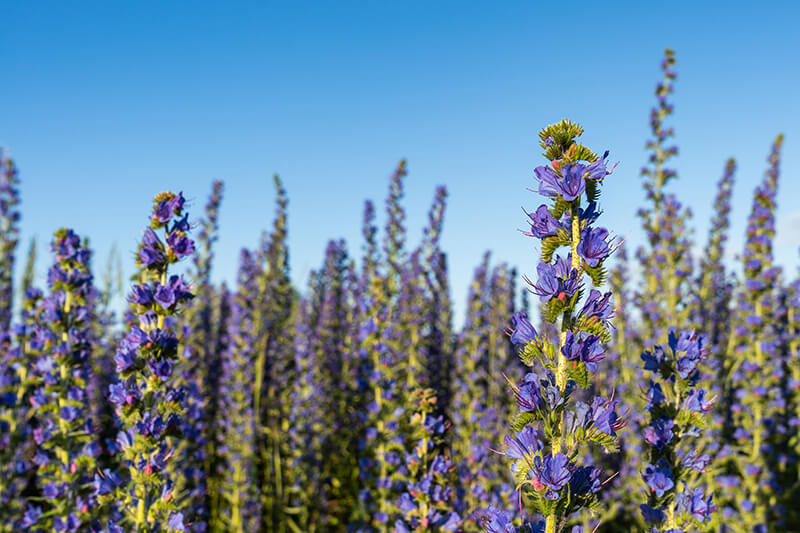
- 🔮 Symbolism: Deceipt
- 💧 Water needs: Dry to medium
- 🪴 Soil needs: Average soils with good drainage
- 🌍 Growing zones: 4 to 8
- ☀️ Light needs: Full sun
- 🌱 Blooming season: May into September
To some, viper’s bugloss is a weed, while to others it is a wildflower. Images of these poisonous flowers show tall spikes of blue-petaled flowers with contrasting red stamens. Although this plant is toxic to horses only if a great deal is eaten over a long period of time, it is acutely poisonous to humans.
27. Deadly Nightshade Belladonna (Atropa Belladonna)
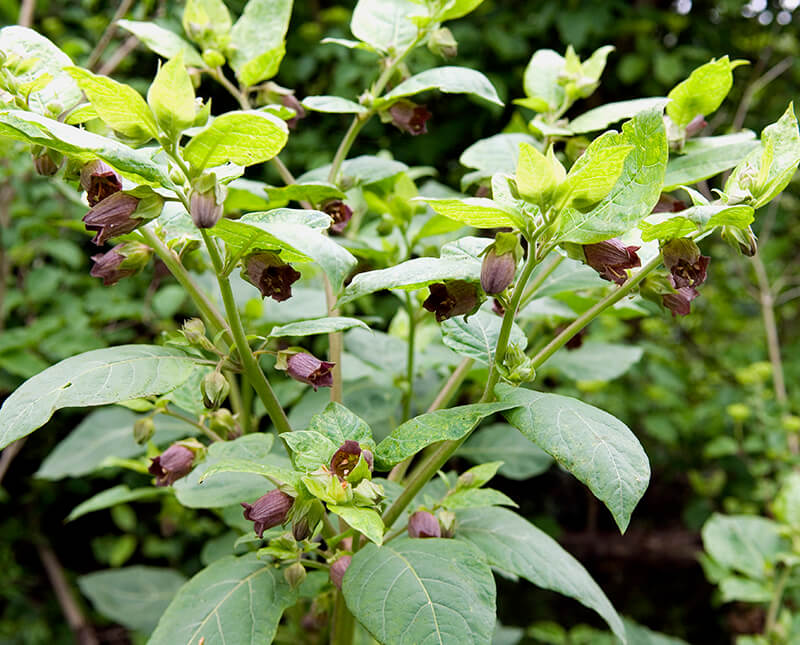
- 🔮 Symbolism: Poison, lies
- 💧 Water needs: Medium
- 🪴 Soil needs: Average soils with good drainage
- 🌍 Growing zones: 5 to 9
- ☀️ Light needs: Full sun to part shade
- 🌱 Blooming season: June to September
Do not be fooled by the muted purple flowers – the deadly nightshade belladonna is one of the world’s most dangerous plants. Every single part of this plant is extremely poisonous – only 10 berries release enough poison to kill an adult. Because it is not recommended for home gardens, it is included here for identification purposes only.
27 Intoxicating Poisonous Flowers and Plants for a Sense of Danger in Your Landscape
Pictures of poisonous flowers show how beautiful they can be in your landscape. Knowing which flowers have toxic properties can also change your garden design. If dogs, cats, horses, or children frequent your garden, you may want to fence off some of these flowers.
Just because these flowers are poisonous does not mean that they should be excluded from your landscape design. Many are even traditional garden favorites. With the exception of deadly nightshade, all of these flowers can add a unique sparkle to your garden. Additionally, a little danger can add a new dimension to a familiar outdoor space.

